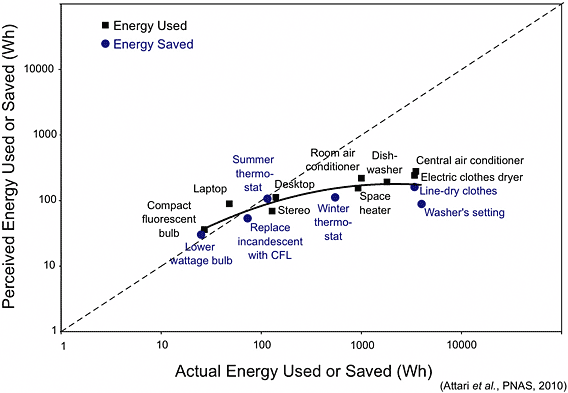Biodegradable Envelope, Please
How did readers do on Slate's energy consumption quiz?
To mark Earth Day last week, Slate challenged readers to guess the amount of energy common household devices like computers and dishwashers consume. The results of a similar, longer survey published in the Proceedings of the National Academy of Sciences in August found that the 505 participants typically underestimated energy consumption, guessing that appliances used nearly half as much as they actually do, on average. (We consulted with that study's two lead authors, Columbia University's Shahzeen Attari and Ohio State University's Michael DeKay, for our quiz.) So how did the 13,000-plus respondents to Slate's quiz do?
Pretty well. The graph below gives a bird's-eye view of the guesses and answers. For each device, the actual energy-consumption value is plotted on the horizontal axis, while the median Slate reader's guess is plotted on the vertical axis. The diagonal line through the chart is what we're calling the "line of correctness": The closer a point is to the line, the closer the median guess was to the actual answer.
The median guess among Slate readers was dead-on for four of the nine devices: the compact fluorescent lightbulb, stereo, portable heater, and room air conditioner. Those devices aside, readers generally a) slightly overestimated how much energy the less energy-intensive appliances used and b) significantly underestimated how much energy the more energy-intensive appliances used. Attari's team says this pattern, which they also found among their survey-takers, is the product of two main psychological effects. The first is known as the "anchoring effect." In both the study and the Slate quiz, readers were asked to compare appliances with the amount of energy consumed by a 100-watt lightbulb, the "anchor." Most respondents guessed that all items are closer to this base value than they really are. The second effect, "compression bias," is a byproduct of anchoring and describes the way we tend to guess that all values are closer to one another than they really are.

It appears that Slate readers did better at the median than the PNAS participants (plotted on the graph above), largely due to less severe underestimation. The median guess for a central-air conditioner was 300 watt-hours in the PNAS survey and 1,500 watt-hours in the Slate quiz—much closer to the actual value of roughly 3,500 watt-hours. I can think of several reasons for this. It's certainly possible that people have become better-informed about energy consumption in the two years between the original survey (given to participants on Feb. 11, 2009 online) and Slate's quiz. It's also possible that people self-selected to take our quiz more than they did to take Attari's. And, finally, Slate readers weren't prevented from replaying the quiz after learning the correct answers, something the PNAS survey disallowed.
In addition to the guess-the-energy-use questions, the quiz included two questions that asked readers to rank two sets of activities by how much energy they consumed. Readers did impressively well on the first ranking question, correctly ranking (on average) airplanes as the most energy-intensive way to ship one ton of freight, followed by trucks, ships, and then trains. Twenty-two percent of respondents got the ranking exactly right. Slate readers, like Attari's participants, did significantly worse on the second question. Only 7 percent of respondents correctly ranked the following types of containers by how much energy it takes to make them: A virgin-glass bottle requires the most, followed by a recycled-glass bottle, a virgin aluminum can, and finally a recycled aluminum can. On average, readers correctly ranked the virgin products as more energy-intensive than the recycled products but flipped the order of the glass bottles and aluminum cans.
Several commentors took issue with quiz's answers, offering alternative energy-consumption values and rankings for computers, dishwashers, heaters, and commercial freight transportation. Others noted that the answers might be more appropriately expressed as ranges, since not every air conditioner, for example, uses the same amount of power. Both criticisms are valid. We took our numbers directly from the PNAS paper that we based the rest of the quiz on. In turn, the authors say (as we noted in the quiz) that those answers are averages of the best available range of estimates. This doesn't make them perfect; reliable, up-to-date data on appliances' energy use are incredibly difficult to find and must be compiled piecemeal when available. So here's another plea to the Department of Energy and big-box retailers: Build us this database!
Like Slate on Facebook. Follow us on Twitter.
